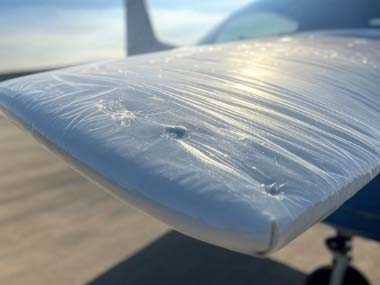Instant Hull Heal Packing IHH-P
Instant Hull Heal Packing (IHH-P) Specification
Purpose:
- To provide a rapid, temporary seal for bullet holes or similar punctures in aircraft hulls, ensuring cabin pressure is maintained until repairs can be made.
Material Composition:
- Primary Material:
- High-Density Polymer Resin - A blend of synthetic resins with properties similar to those used in self-healing materials, capable of polymerizing upon exposure to air or specific environmental conditions. This could include materials like Polyurethane or advanced silicones with embedded microcapsules containing healing agents.
- Reinforcement Fibers:
- Aramid Fibers (like Kevlar) or Carbon Nanotubes for strength, flexibility, and to enhance the healing process by providing structural integrity.
- Activator/Healing Agent:
- Microencapsulated Healing Compounds - Upon damage, these capsules rupture, releasing agents that react with the polymer matrix or ambient air to form a solid plug. The agents could be similar to those used in self-healing concrete or polymers, like dicyclopentadiene (DCPD) and a catalyst like Grubbs' catalyst.
Physical Properties:
- Weight: Extremely lightweight, aiming for a density less than 1.2 g/cm³ to minimize impact on aircraft performance.
- Density: Optimized for minimal weight while maintaining high strength-to-weight ratios.
- Flexibility: Flexible enough to conform to irregular shapes or angles of bullet impacts but with sufficient rigidity to maintain structural integrity.
- Temperature Resistance: Must withstand temperatures from -50°C to +150°C without degradation, covering the range of potential flight conditions.
- Pressure Tolerance: Capable of sealing under pressures up to 100 kPa (the typical pressure differential in commercial aircraft cabins).
Healing Mechanism:
- Activation: The material should activate upon exposure to air or a detected drop in pressure, causing the healing agents to polymerize and seal the breach.
- Healing Time: Instantaneous (within seconds) to ensure rapid pressure retention.
- Seal Strength: The plug should have sufficient strength to withstand internal cabin pressure without further degradation or expansion of the initial hole.
Application Method:
- Installation: Applied as an inner liner within the aircraft's hull, possibly as a spray-on coating or embedded within existing structural layers.
- Maintenance: Minimal maintenance required; self-healing properties should allow for repeated use without significant degradation.
Durability and Longevity:
- Lifespan: Designed for the operational life of the aircraft with a degradation rate low enough to not require frequent replacement.
- Environmental Resistance: Resistant to UV light, moisture, and common aviation chemicals like fuels, hydraulic fluids, and de-icing agents.
Safety Considerations:
- Non-Toxic: All components must be safe for human exposure in case of cabin decompression or material failure.
- Fire Resistance: Must meet or exceed aviation standards for fire safety, not contributing to fire spread or smoke emission.
Testing and Certification:
- Compliance: Must comply with aviation safety regulations (e.g., FAA or EASA standards).
- Testing: Extensive testing for bullet impact resistance, pressure retention, and healing efficiency under simulated flight conditions.
Keywords
high-density polymer resin self-healing materials aramid fibres carbon nanotubes microencapsulated healing compounds lightweight flexibility temperature resistance pressure tolerance instant healing cabin pressure aviation safety hull breach polymer matrix healing agents structural integrity moisture resistant fire resistance non-toxic standards
